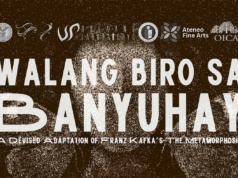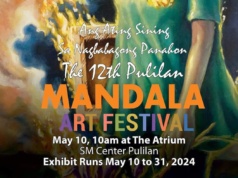Richard Buxani

February 7 – 28, 2023
Artist Reception
February 15 | 3:00 PM
NCCA Gallery
National Commission for Culture and the Arts
“I work as if I am living in borrowed time… Live without regrets. Work and play like there is no tomorrow.”
— Richard Buxani
Richard Buxani hems intergenerational narratives in the exhibition “MAKINA,” centering on the sewing machine as an object located within nodes of signifiers.
We recall grandmothers and mothers sewing for their children. They sustain the family or sew at leisure as a gesture of care. The thought overlaps with the image of women in homes, ode-street dress shops, and factories stitching cloth and spinning fiber.
Mothers are the heart of the home, shrouding us with warmth and strengthening the family at the seams. Their nurturing image is embossed in us until we reach our twilight years. Words of a mother can mend our frayed psyche and ruptured dreams. Her tender touch drapes us in comfort. Guided by her firm and steady hands, we helm our dreams, thread our life patterns, and string beadworks of aspirations in the process.
We embroider personal memories of how maternal affection fuels the creative labor interlaced in textiles; the hum and rhythm of sewing are now embedded in our unconscious.
Collective and personal memories are patches on a quilt: life stories are intertwined, and the sinews and seams are strengthened. The mother’s feeble hands are frail yet graceful, wrinkled with age yet nimble, guiding every stitch with one hand while the other rests on fabric as the wheel steadily spins.
Every slip, zigzag, backstitch, and cross-stitch encodes interstitial creativity and wisdom transmitted across time. We then endow needlework with enormous respect, asserting that artisans transform our heritage places into our common home and enshrine the legacy of generations of women who have sewn on sewing machines.
Abe Orobia, the exhibition curator, highlighted “Buxani’s processes in collecting, selecting, conceptualizing, and designing his pieces.” To him, Buxani’s “use of old sewing machines as benches makes it contemporary and exceptional.”
Found and discarded objects are repurposed and upcycled. Parts of sewing machines that fell to disuse are given new life, transforming each into utilitarian yet aestheticized objects. One can sit on them, converse with kindred souls over a drink, play a board game, tinker and admire the workmanship of each piece, or simply revel in the lull of the wind and the soft rustle of leaves in the garden.
The idea that bonds are strengthened and resilient since our formative years animates the exhibition. A few works are collaborations with fellow artists, where chairs are painted on to look like fabric or upholstery one finds in domestic spaces, and each layer of pigment signifies the creativity and friendship binding one artist to another.
Some take the shape of pin poppets and other figures imbued with mythological references related to sewing and motherhood Parts of the sewing machine are transmuted into forms that highlight the materiality, made significant by the stories.
Instructive in Buxani’s works is how technological changes led to the use of digital sewing machines and the death of an era. Yet these are transformed by the artist and given an afterlife.
— Laya Boquiren
About the Artist































